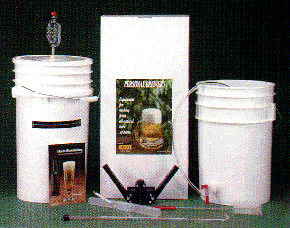Brewtopia Events
More homebrewing information from Brewtopia Events...
How
to Brew Simplified 3 Gallon Batches of All-Grain Homebrew
Recipes
for the above procedure.
Beer travel on our
Brewtopia Events webpage...


|
|
Equipment
Needed for
Bottling Your Homebrew:
- Racking cane and 3 feet of siphon
hose.
- Bottling bucket with spigot.
- Bottling tube with spring/pressure
flow tip.
- Bottles and caps.
- Bottle capper.
- Sanitizer such as unscented bleach.
- Five Star Star-San no-rinse acid sanitizer.
- Powdered homebrewing sanitizer
(oxygen or chlorine-based).
- Automatic dishwasher.
- Corn sugar for priming (carbonating).
|

|
 Bottling Bottling
General Information: You will need 48 twelve ounce
bottles for
five gallons of beer, but only 28 for a three gallon batch. For mild
carbonation,
you should add around 3/4 ounce of corn sugar to prime (carbonate) each
gallon of finished beer you end up with in your bottling
bucket.
Keep in mind that if you have three gallons of beer in your fermenter,
you will end up with a little over 2 1/2 gallons in your bottling
bucket
once you siphon it off all the yeast sediment. Don't overprime!
Important Steps:
- Be sure all your bottles are the thick returnable type that
can handle
repeated use. Soak and scrub off all the labels and be sure each bottle
is free of debris or moldy areas inside. Soak bottles
in a bucket of STRONG bleach solution overnight and then use a bottle
brush to be sure each bottle's interior is free of sediment or residue.
- The night before you are going to bottle your beer, set all
needed
bottles
on your kitchen counter top and fill each bottle with water and Star
San solution. Let these bottles soak overnight.
- Also on the night before you are going to bottle your beer,
fill your
bottling
bucket (with hoses, racking canes, and racking tips inside) with water
and Star San. Let these all soak together
overnight.
- The next day, empty your bottles of all the water and
sanitizer and put
them
upside down on the prongs in your dishwasher. Sprinkle a tiny bit of
powdered
homebrewing sanitizer/cleaner in the bottom of the dishwasher and run
your
bottles through the longest, hottest cycle. Keep the door of the
dishwasher
closed until you are ready for your bottles (this will keep them
sanitized).
- When you are ready to bottle, dump the water and Star San
out of your bottling bucket. One quick rinse with hot tap water
won't hurt.
- Count out how many bottle caps you will need and soak these
for ten
minutes
in a little vodka or a cup of water in which you have dissolved one
Campden
tablet. (Campden is a safe, no-rinse sanitizer that will not destroy
the
preserving capabilities of oxygen-absorbing bottle caps.)
- Boil your carefully measured corn sugar in about one cup of
water for
ten
minutes and add this hot liquid to the bottom of your bottling
bucket.
- If you have made only three gallons, this amount of beer
will not weigh
that much, so you can siphon from your fermenter into your bottling
bucket
placed right on the open door of your dishwasher. Place your bottling
bucket
with corn sugar on the open door of your dishwasher and position your
fermenter
on the counter right above the dishwasher. Carefully siphon the beer
into
the bottling bucket (leaving the yeast sediment behind in the
fermenter).
If you drip or spill, you'll spill onto the door of the dishwasher, and
will not make a mess.
- Now place your bottling bucket on the counter above the
dishwasher.
Using
the siphon hose, bottling cane, and pressure filler tip, grab and fill
each beer bottle right on the door of the dishwasher.
- Grab a bottle cap out of the Campden solution, shake it a
couple of
times
to shake off excess solution, and cap your bottle using the capping
mechanism
of your choice.
- Use a sharpie marker to mark a code and date on top of the
bottle cap
to
identify the beer. Don't bother with labels unless the beer is going to
be used as a gift. Most labels are very hard to remove.
- When all bottles are capped, rinse out your bottling bucket
and hoses,
and again soak them with water and a big shot of chlorox for a few
hours.
- Drain the chlorox solution out of your bucket and hoses (do
not rinse)
and put all equipment away after everything is just about dry.
You can see how valuable a tool the dishwasher is at bottling
time!
Also be sure to carefully rinse out each beer bottle immediately after
you drink your beer out of it. I keep a spray bottle of water and
bleach under the sink to spray into each empty bottle that I'm going to
use again. I top the bottle up with cool water and leave it on
the counter overnight before I store it away for next time. This
insures that no mold grows in
the
bottles before you need the bottles again.
*** Click here
for great all-grain brewing tips ***
*** Click here
for recipes ***
|

